Abstract
Background and aims
The impact of electronic cigarettes (ECs) on nicotine use is hotly debated: some fear that ECs are a ‘catalyst’ to conventional smoking, while others argue that they divert adolescents from the more harmful product. This study used simulation modeling to evaluate the plausibility of catalyst and diversion hypotheses against real‐world data.
Design
A simulation model represented life‐time exclusive EC use, exclusive conventional smoking and dual use as separate subpopulations. The ‘catalyst’ effect was modeled as EC use increasing dual use initiation (i.e. EC users also start smoking). The ‘diversion’ effect was modeled as EC use decreasing exclusive cigarette initiation. The model was calibrated using data from the US National Youth Tobacco Survey (NYTS). The plausibility of each scenario was evaluated by comparing simulated trends with NYTS data. This is the first study, to our knowledge, to estimate the magnitude of a diversion effect through simulation.
Setting
United States.
Participants and measurements
Adolescents aged 12–17 years in NYTS, a cross‐sectional study from 2000 to 2019 (n = 12 500 to 31 000 per wave). Exclusive cigarette use, exclusive EC use and dual use of both products were defined using cumulative life‐time criteria (100+ cigarettes smoked and/or > 100 days vaped).
Findings
A null model (no catalyst or diversion) over‐predicts NYTS smoking by up to 87%. Under the conservative assumption that the catalyst effect accounts for all dual use, an exponential decay constant of 19.6% EC users/year initiating smoking is required; however, this further over‐predicts actual smoking by up to 109%. A diversion effect with an exponential decay constant of 55.4%/year or 65.4%/year, with the maximum possible opposing catalyst effect also active, is required optimally to match NYTS smoking trends (root mean square error = 286 632 versus 391 396 in the null model).
Conclusions
A simulation model shows that a substantial diversion effect is needed to explain observed nicotine use trends among US adolescents, and it must be larger than any possible opposing catalyst effect, if present.
Keywords: Adolescents, cigarettes, diversion, electronic cigarettes, nicotine use, simulation modeling
Introduction
Cigarette smoking remains the primary cause of preventable death in the United States [1]. Despite successful tobacco control efforts, prevalence rates have plateaued among adults [1, 2]. Until recently, the predominant nicotine product in the United States was conventional cigarettes. Electronic cigarettes (ECs) have drastically changed this pattern, starting around 2010, particularly among youth [3]. However, this has been offset to some degree by an all‐time decline in conventional cigarette use and a greater trend towards the use of multiple tobacco products, particularly of cigarettes with e‐cigarettes (Fig. 2) [3, 4]. The United Kingdom and Canada show similar opposing trends of EC versus cigarette use, although EC use is higher in the United States [5].
Figure 2.
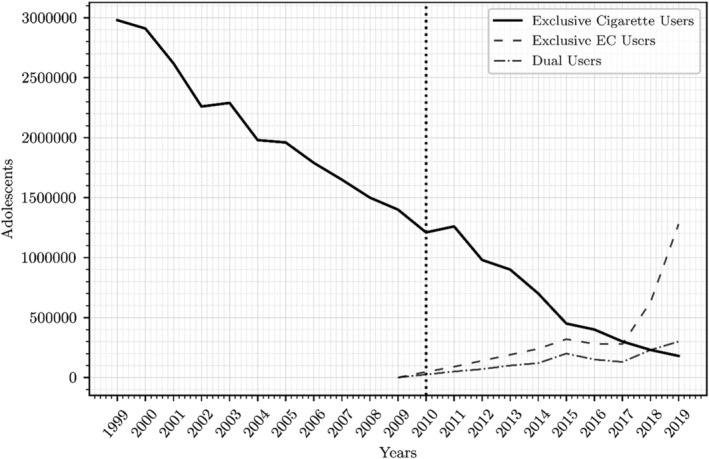
Historical data on exclusive cigarette, exclusive electronic cigarette (EC) and dual use of both products among US adolescents. Source: National Youth Tobacco Survey, 2000–19. The dotted vertical line at 2010 indicates approximately when e‐cigarettes appear
The implications of ECs are a matter of active debate. Many fear that ECs may represent a ‘catalyst’ to nicotine use (including smoking). In support of the catalyst hypothesis, EC users are reported to be at risk for later smoking conventional cigarettes [6, 7, 8], although this association may be due to residual confounding bias in their analyses [9]. A catalyst effect could occur via nicotine dependence [10, 11, 12, 13] (although this lacks empirical evidence) [14], desensitization to aversive sensations of smoking [13, 15] or reduced harm perceptions of cigarettes [16]. In contrast to a direct catalyst effect, ECs may also indirectly increase cigarette smoking via ‘renormalization’, i.e. making smoking become more socially acceptable, although supporting evidence is weak [17, 18].
Conversely, ECs have a potential for harm reduction: ECs are estimated to be only a fraction as harmful as conventional cigarettes [19], and are often used by smokers to reduce or quit conventional smoking [20, 21]. An important as‐yet unstudied potential benefit is whether ECs are a primary prevention tool for cigarette smoking [22]; that is, whether ECs divert adolescents from ever using conventional cigarettes. This could occur if a subpopulation has a pre‐existing propensity for nicotine use [9], and are simply using ECs instead of cigarettes. In support of the diversion hypothesis, declines in conventional smoking prevalence accelerated after ECs became available [4, 23], resulting in an overall balance with respect to the use of any nicotine product [24, 25].
Empirical support for each of these hypotheses remains uncertain due to limitations of available data. Regarding the diversion hypothesis in particular, the inability to observe counterfactuals make it very difficult to estimate what conventional smoking prevalence would have been in the absence of ECs. The statistical approaches conventionally used in the field are extremely limited in examining the question of diversion. Simulation modeling is an important complementary tool due to its ability to simulate dynamic behavior under different scenarios (e.g. diversion and catalyst hypotheses), while constraining all else to remain equal.
The current study uses system dynamics simulation modeling to capture trends in the prevalence of (1) exclusive conventional use, (2) exclusive EC use and (3) dual use of both products during the period 2000 to 2019. The model is calibrated to historical data from US adolescents during 2000 to 2010 (pre‐ECs). Simulated nicotine use trends are projected under the assumptions of (a) a null model (neither catalyst nor diversion), (b) the catalyst hypothesis (as opposed to renormalization, for which evidence is weak) [17, 18] and (c) the diversion hypothesis, projected for 2011 to 2019 (post‐ECs). Simulated behavior is compared to observed data to evaluate the consistency of each hypothesis with actual observed data.
Methods
Historical data
Historical data from 2000 to 2019 on the use of ECs and cigarettes among US adolescents (inclusive of 12–17‐year‐olds) were drawn from the National Youth Tobacco Survey (NYTS), a large national survey which is representative of adolescents in the United States (described in detail in the Supporting information). Sample size varied across year and ranged from approximately n = 12 500 to n = 31 000 per wave.
Nicotine use was categorized into three mutually exclusive categories of life‐time use: exclusive cigarette use, exclusive EC use and dual use of ECs and cigarettes (details available in the Supporting information). Notably, use definitions were based on cumulative life‐time exposure, not current use, as this is relevant to population health outcomes, even among adolescents [26]. Thus, life‐time dual use reflects becoming established users of both substances at some point, and not necessarily concurrent use.
Hypotheses
The catalyst hypothesis postulates that EC use influences some non‐smokers to later also progress to smoking (i.e. life‐time dual use). An important claim of the catalyst hypothesis is that ECs attract new populations of nicotine users [7, 12], as opposed to merely those who would have smoked cigarettes regardless. By definition, the catalyst hypothesis does not affect exclusive smokers (as they do not use ECs). Therefore, we model the catalyst hypothesis as a flow which depletes the ‘stock’ (somequantity that accumulates or depletes) of exclusive EC users and increases the stock of dual users beyond what it would have otherwise been.
The diversion hypothesis postulates that EC use entirely prevents some adolescents from ever using conventional cigarettes. Conceivably, a diversion effect could also prevent dual use; we have made a simplifying assumption that this is negligible, due to the low prevalence of dual use and the evident diversion effect in exclusive smoking post‐ECs [4]. Therefore, the diversion hypothesis is modeled here as decreasing the exclusive cigarette initiation rate below what it would have otherwise been.
The diversion and catalyst effects oppose each other with respect to their effects on total nicotine use. Both were modeled because (a) it is possible for both mechanisms to occur simultaneously, and (b) as the catalyst and diversion effects act on different variables (dual use and exclusive cigarette use, respectively), their effects can be separated for analysis.
System dynamics model
A simulation model using Stella Architect version 1.9.5 [27] (Fig. 1) was built, which modeled (1) exclusive cigarette users, (2) exclusive EC users and (3) dual users as separate stock‐and‐flow structures (a stock with associated inflows and outflows that cause accumulation and depletion, respectively, of the stock). Each stock has an inflow of initiation rate and an outflow of maturation rate (i.e. exiting the age range under consideration). Outflows of quitting were excluded based on our definitions of cumulative life‐time exposure, which is an irreversible process. Non‐users of either substance were not explicitly modeled, but are captured implicitly in the adolescent maturation rate and user ratios. We model EC use (alone or with cigarettes) as independent (i.e. not offsetting) exclusive cigarette use, which allows for would‐be never‐smokers to use ECs; this is a conservative assumption that over‐estimates total nicotine use and biases results towards a catalyst hypothesis. As this is a population‐level simulation model, adjustment for socio‐demographics was not performed. Details of the model, including equations, are available in the Supporting information.
Figure 1.
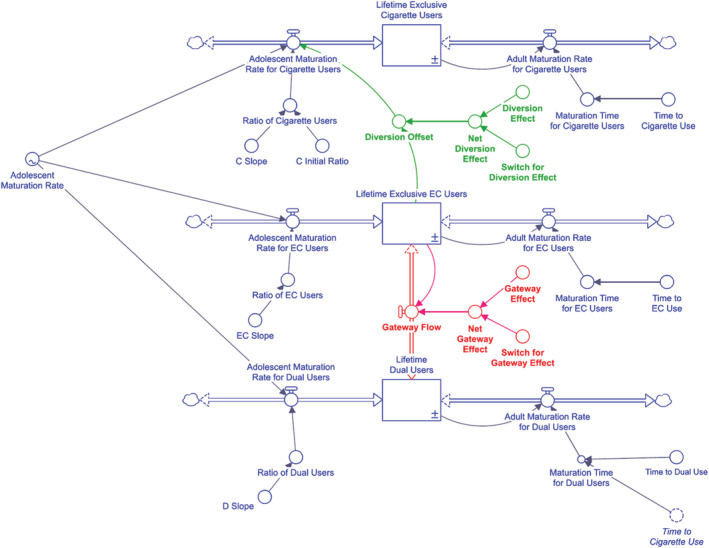
Simulation model structure. [Colour figure can be viewed at wileyonlinelibrary.com]
Calibration and optimization
Calibration was performed in several stages, first for behavior mode replication (i.e. to achieve a good fit between simulated data and historical NYTS data) and next to quantify the magnitude of catalyst and/or diversion effects that are necessary to explain observed nicotine use trends (see the Supporting information for details).
Base‐case, counterfactual model
First, building upon recent work [4], calibration for 2000–10 was performed to replicate exclusive cigarette use trends before the appearance of ECs (circa 2010) in order to obtain a base‐case ‘counterfactual’ scenario of what exclusive cigarette use would have looked like in the absence of ECs. Optimization was performed to tune inflow and outflow parameters to minimize squared error between the simulated and real NYTS values of exclusive cigarette use. Using the resulting parameter values, a base‐case counterfactual scenario was obtained by running the model into the post‐EC era (2011–19).
Null model
Next, calibration of EC and dual use parameters was performed under a ‘null model’ in which both catalyst and diversion effects are switched off. Parameter values were selected which maximized the fit between simulated and NYTS values of exclusive EC use and dual use.
Catalyst‐only model
The catalyst effect was calibrated by optimizing the match between simulated and real data for both EC users and dual users. As it cannot be known how many dual users in NYTS entered that stock through the ‘naturally occurring’ inflow versus the catalyst inflow, we estimate the worst‐case scenario: the magnitude of the catalyst effect that would be required to explain all dual use.
Diversion‐only model
The diversion effect was calibrated by optimizing the match between simulated and NYTS data on exclusive cigarette use. This quantifies how large the diversion effect would need to be to explain observed trends.
Diversion + catalyst model
Because it is possible for both diversion and catalyst mechanisms to be occurring simultaneously, the diversion effect was calibrated once more using the scenario that an opposing catalyst effect is also active.
Validation
The model was subject to basic validation tests, including ensuring that stocks do not become negative, extreme conditions testing (0 and very high values of inflows and initial values of stocks) and behavior mode replication. Additionally, ‘reality checks’ of the catalyst and diversion effects were conducted by switching each effect ‘on’ one at a time, and observing the effects on dual use (which should increase) and exclusive cigarette use (which should decrease), respectively. Next, as the calibrated models for catalyst and diversion were optimized to match one local behavior in the model (i.e. dual use and cigarette use, respectively), validation tests were performed on each model's behavior with respect to trends in the relevant broader measure of model behavior (i.e. total cigarette use for the catalyst model and total nicotine use for the gateway model). Finally, sensitivity testing was performed by varying the size of the catalyst and diversion effects by 50% in either direction.
These analyses were not pre‐registered and the results should be considered exploratory.
Results
Figure 2 shows NYTS cigarette and EC use trends during 2000 to 2019, showing a continuous decline in exclusive cigarette use, followed by increases in EC and dual use after becoming available ~2010.
The model replicated historical data in exclusive cigarette use to 2010 (Fig. 3) under the null model (no catalyst or diversion). The trends calibrated to the pre‐EC time‐period predict more exclusive cigarette smokers than were actually observed between 2011 and 2019 by up to 87% in 2018. This discrepancy is examined further using the catalyst and diversion scenarios below.
Figure 3.
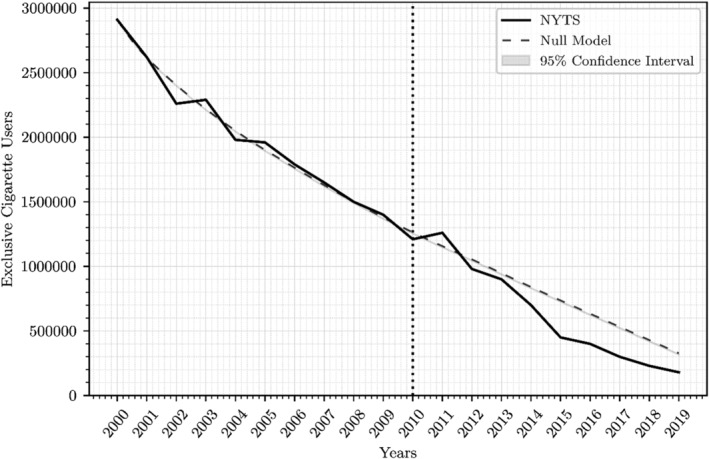
Historical versus simulated data in exlcusive cigarette use, under the base‐case assumption (no catalyst and no diversion effects). The model was calibrated to National Youth Tobacco Survey (NYTS) data, and calibration was performed from 2000 to 2010 in order to project a base‐case counterfactual scenario in the absence of electronic cigarettes (ECs). Parameters determining the slope of the inflow (cigarette initiation rate) were optimized to achieve this best fit. ECs appeared in approximately 2010 (dotted vertical line)
Validation checks of the catalyst‐only and diversion‐only effects are shown in Figs 4 and 5, respectively, versus the null model. Both effects are quantified using exponential decay constants that describe the speed of decline (here, the percentage of EC users per year who become dual users or are preventing from becoming cigarette smokers, for catalyst and diversion effects, respectively). A catalyst effect with an exponential decay constant of 25%/year projects approximately 45% more dual users in 2019 than there would have been in the absence of ECs (Fig. 4). Conversely, a diversion with an exponential decay constant of 25%/year projects approximately 51% fewer exclusive cigarette users than would have been in the absence of ECs (Fig. 5).
Figure 4.
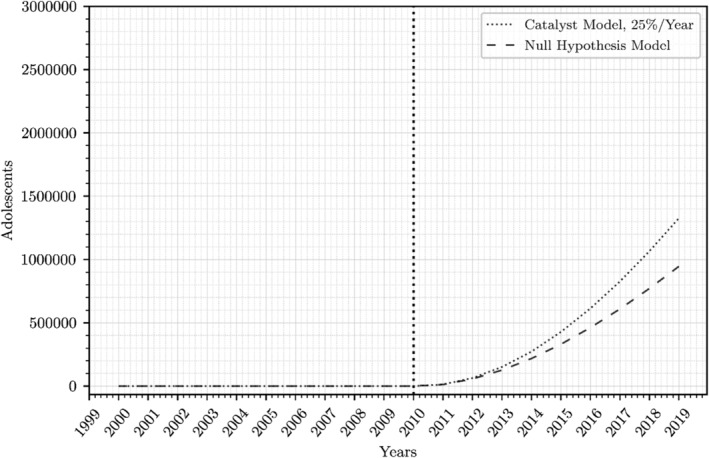
Trends in dual use [using both cigarettes and electronic cigarettes (ECs)] under the base‐case simulation (no catalyst or diversion effects) and the catalyst simulation. The catalyst effect is estimated to have an exponential decay constant of 25%/year here. ECs are estimated to have appeared in 2010 (dotted vertical line)
Figure 5.
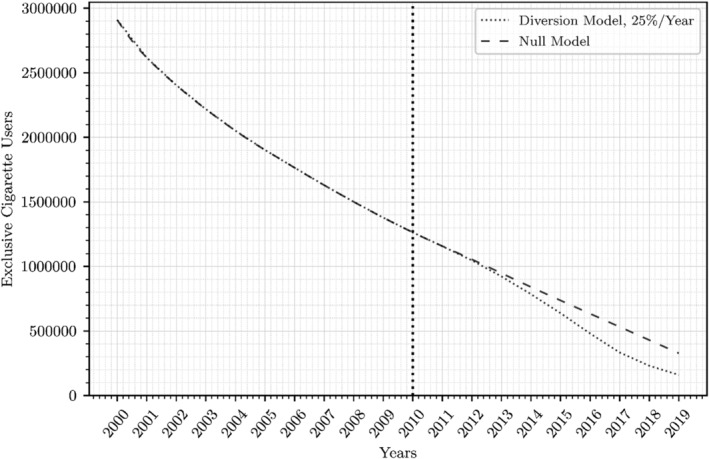
Trends in exclusive cigarette use under the base‐case simulation (no diversion or catalyst effects) and the diversion simulation. The diversion effect is estimated to have an exponential decay constant of 25%/year here. Electronic cigarettes are estimated to have appeared in 2010 (dotted vertical line)
Figure 6 shows total nicotine use trends under the null, catalyst and diversion scenarios, plotted against actual NYTS data. The actual data on total nicotine use is noticeably lower than is projected under the catalyst and null hypotheses, with the exception of the 2019 data point (see Discussion). Conversely, the diversion hypothesis more closely fits the observed data [root mean square error (RMSE) = 292 942 versus RMSE = 374 253 for the null model and RMSE = 391 396 for the catalyst model], but still appears to over‐predict the total nicotine users (again except 2019).
Figure 6.
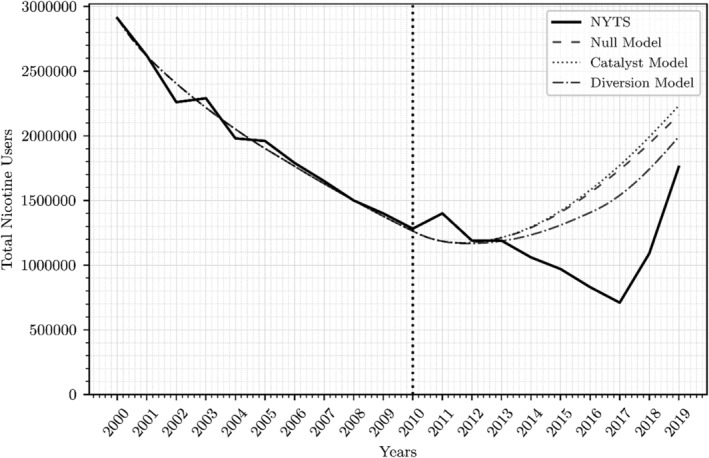
Trends in total nicotine use (exclusive cigarette use, exclusive electronic cigarette use and dual use combined) under the catalyst (0.25%/year) and diversion (0.25%/year) scenarios, compared with actual trends based on National Youth Tobacco Survey (NYTS) data. Electronic cigarettes are estimated to have appeared in 2010 (dotted vertical line)
Next, despite the catalyst effect over‐predicting total nicotine use, the magnitude of a possible catalyst effect was estimated by calibrating dual use trends to NYTS data. Importantly, this represents an extremely conservative assumption that the catalyst effect fully accounts for all dual use: as there is no way to know what fraction of dual use is attributable to the catalyst effect in NYTS, we estimate the maximum possible catalyst effect. A catalyst effect with an exponential decay constant of 19.6% EC users/year who become dual users was necessary to optimize the fit between simulated and NYTS data on dual use. The effect of this calibrated catalyst effect on total cigarette use shows that this maximum possible catalyst effect also over‐predicts total cigarette use (either alone or with ECs) by up to 109% in 2017 (Fig. 7). Sensitivity testing shows that varying the catalyst effect by up to 50% still over‐predicts real data.
Figure 7.
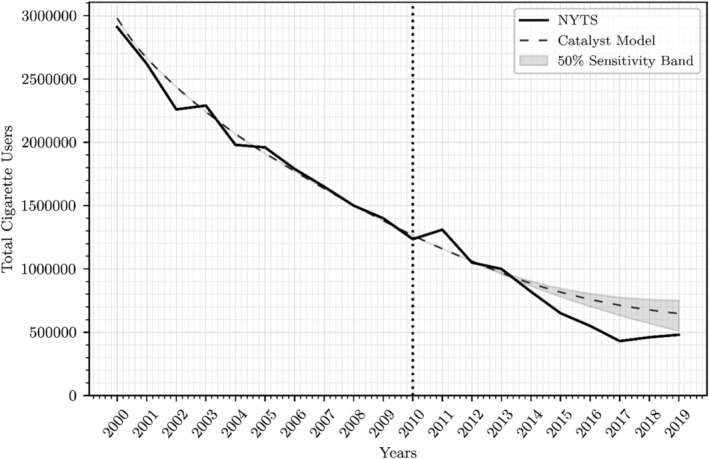
Total cigarette use (exclusive cigarette use and dual use) trends under the calibrated catalyst effect. The catalyst effect was optimized to achieve the best fit between simulated and actual data in dual use, under the extremely conservative assumption that all dual use is accounted for by the catalyst effect (exponential decay constant of 19.6%/year). Here, the diversion effect is shown against historical data using National Youth Tobacco Survey (NYTS). Electronic cigarettes (ECs)are estimated to have appeared in 2010 (vertical line). The band represents the range covered in the sensitivity analysis (i.e. a 50% change in either direction of the diversion effect parameter). ECs are estimated to have appeared in 2010 (dotted vertical line)
Next, as the diversion effect is more consistent with, but still overshoots, observed data, the magnitude of the diversion effect was quantified using Stella's optimization tools (see Methods/Calibration and Optimization section). Results show that the diversion effect must have an exponential decay constant of 55.4% of EC users/year who are prevented from becoming established smokers in order to most closely match NYTS smoking rates. When the maximum opposing catalyst effect (Fig. 7) was also active, a diversion effect with an exponential decay constant of 65.4%/year was necessary. Thus, even when an opposing, upper‐limit catalyst effect is active, the diversion effect must be greater in magnitude to explain observed trends. The effect of this calibrated catalyst effect on total nicotine use is shown in Fig. 8: this shows that the calibrated diversion effect more closely matches total nicotine use, including the increase in 2019 (RMSE = 286 632). Sensitivity testing shows that varying the diversion effect by up to 50% still approximately replicates NYTS trends.
Figure 8.
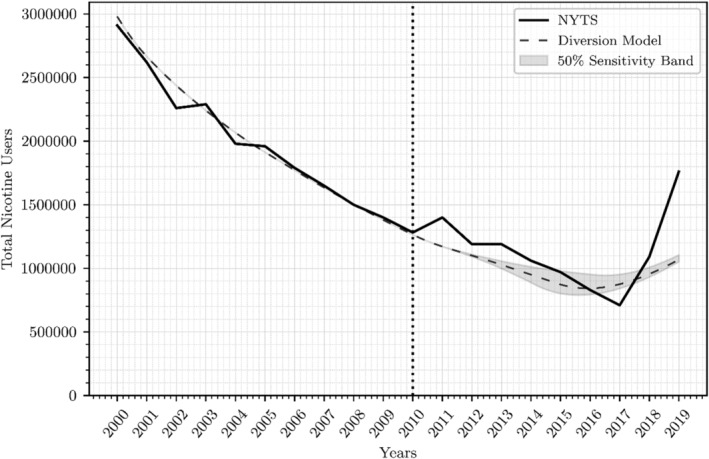
Trends in total nicotine use (exclusive cigarette use, exclusive electronic cigarette use and dual use combined) under scenarios using the calibrated diversion effect. The diversion effect was optimized to achieve the best fit with exclusive cigarette use (exponential decay constant of 55.4%/year or 65.4%/year, depending on whether or not an opposing catalyst effect is also active). Here, the diversion effect is shown against historical data using National Youth Tobacco Survey (NYTS). Electronic cigarettes (ECs) are estimated to have appeared in 2010 (vertical line). The band represents the range covered in the sensitivity analysis (i.e. a 50% change in either direction of the diversion effect parameter). ECs are estimated to have appeared in 2010 (dotted vertical line)
Discussion
This paper used a simple stock‐and‐flow model to replicate trends in observed data on exclusive cigarette, exclusive EC and dual use during the period 2000 to 2019 (with ECs first appearing around 2010) in the United States. Given that nicotine use in general, and cigarette smoking in particular, were lower after the appearance of ECs (~2010) than would be expected otherwise [4], a substantial diversion effect with an exponential decay constant of 55.4% EC users/year being prevented from ever using cigarettes is necessary to explain observed data. Although it is theoretically possible that a catalyst effect occurs for some adolescents, a net diversion effect must be present to replicate NYTS trends: in the presence of the maximum possible opposing catalyst effect (19.6% EC users/year also initiating smoking), the diversion effect is 65.4%/year. This study is the first, to our knowledge, which attempts to quantify the possible diversion effect of ECs using simulation modeling.
The effect of ECs on nicotine use (including subsequently initiating smoking) remains controversial in the literature, due to the recency of data on ECs (particularly longitudinal data) and the inability to measure with certainty what would have happened in the absence of ECs. The majority of the literature examining the impact of ECs on subsequent conventional smoking has concluded that they have a catalyst effect [7, 8, 12], even after controlling for shared risk factors between EC and cigarette use. This includes several meta‐analyses which concluded that ECs plausibly have a causal effect on later initiation of conventional cigarettes [28]. However, given severe confounding in the association between EC and cigarette use (e.g. peer and family substance use, personality traits, mental health conditions), even regression adjustment is well known in the causal inference to contain residual bias [29, 30], as demonstrated recently in the context of potential catalyst effects on conventional smoking [9, 31]. Even more optimistically, Shahab et al. used the same method to show that ECs have a protective effect against conventional smoking [32].
Largely absent from this debate is the question of diversion in the sense of primary prevention, as pointed out by McGraw [22]. Not only does the current study demonstrate that actual data are much more consistent with a diversion effect than a catalyst effect, but the magnitude of this effect is somewhat large, even using conservative assumptions. This is consistent with other recent research showing that declines in cigarette use have accelerated after the introduction of ECs [4, 23]. Although ECs are not entirely safe, the fact that they are estimated to be only a fraction as harmful as conventional cigarettes suggests that any degree of offsetting of conventional smoking is beneficial from a population health perspective [19, 33].
Of particular note in the current study is the substantial increase in total nicotine use in NYTS 2019 data. Although this may appear alarming, this is largely attributable to exclusive EC use, which was very recently reported to have declined again [34]. Importantly, cigarette use continues to decline monotonically, to a greater degree than would be expected in the absence of ECs, Nevertheless, the high EC use in recent years is potentially concerning, given that ECs present some harms [35]. However, when considering population health, there is a trade‐off between the number of users and the level of harm associated with the product [36]. Given reliable estimates that ECs are only 5% as harmful as conventional cigarettes [19, 33], the higher exclusive EC use observed in 2019 coupled with the substantial diversion away from cigarettes is unlikely to pose negative impacts to population health, and in fact may have a net harm reduction.
It is notable that the simulation model predicted an increase in total nicotine use in 2019 consistent with NYTS data, attributable to exclusive EC use. This increase occurs due to the continuation of projected curvilinear trends from historic data on cigarettes and EC use. Additionally, the model conservatively assumes that EC use adds to, rather than offsets, cigarette use (unless a diversion effect is active) in relation to dual use, which results in higher total nicotine use and favors a catalyst interpretation.
Strengths
First and foremost, this is, to our knowledge, the first study to empirically estimate a potential diversion effect whereby ECs entirely prevent adolescents from ever using conventional cigarettes. This is a critical, but as‐yet unstudied [22], consideration in the debate on whether ECs represent a net harm or a net benefit to population health. Additionally, the use of simulation methods offers an important complement to conventional statistical approaches, and produces projected results under a variety of different tightly controlled scenarios, including the counterfactual scenario of what would have happened in the absence of ECs. The results were robust to even large variations (up to 50% in either direction) of the estimated catalyst and diversion hypotheses, strengthening the findings that a net diversion effect is necessary to explain observed trends. Finally, the use of nationally representative data in the United States on adolescent use of cigarettes and/or ECs in the United States increased the generalizability of findings.
Limitations
The fundamental limitation of this project is that simulation cannot prove or disprove causality in the real world. Specifically, the result that a diversion effect best replicates observed historical data in nicotine use trends does not necessarily prove that ECs divert from conventional cigarettes in this way. However, a well‐validated model that produces realistic behavior among a range of scenarios can increase confidence in the overall finding that the diversion hypothesis is more consistent with real data than is the catalyst hypothesis.
A related limitation is that this model is intentionally simple in scope for the sake of parsimony, but it is possible that there are other major determinants of nicotine trends among US adolescents which are not captured by the model. For example, a national‐level policy entitled the Family Smoking Prevention and Tobacco Control Act was passed in the United States in 2010, and although based on previous policy research we expect the effects to be small [37], it may have contributed somewhat to the decline in conventional cigarette use. Future research is warranted to incorporate such policy effects into the model. However, given our findings of a robust and large‐magnitude diversion effect, it is unlikely that unaccounted‐for confounders completely explain the observed diversion effect. Moreover, replication is needed to examine whether these findings generalize outside the United States; this is plausible, given that increasing rates of e‐cigarette use correlate with decreasing smoking rates in the United Kingdom and Canada [5].
Additionally, caution should be used when generalizing parameters in the model to real‐world situations. In particular, our estimate of the diversion effect represents the optimal value, given other variables, parameters and assumptions specific in the model; however, this estimate will vary with any changes to the model. Also, structures in system dynamics models do not always correspond exactly to the real world (e.g. outflows in aging chains are often represented as first‐order delays, when in reality they are fixed delays). Thus, the calibrated value for the diversion effect should be interpreted comparatively with the calibrated maximum possible gateway effect, rather than in real‐world terms. Moreover, it is possible the diversion effect varies dynamically.
Finally, the validity of the model is constrained by availability of existing data. Although the NYTS data is a strength of this study, there are currently only five data points that assessed EC use and dual use, which increases uncertainty in the calibrated parameters; however, the overall shape of behavior trends are often more important than precise parameters in system dynamics. Continuing research is needed to incorporate newly available data points. Additionally, self‐report may be biased, particularly with respect to NYTS's definition of ECs as devices that ‘usually’ contain nicotine; this over‐inflates EC use prevalence in these data to an unknown degree by participants who vape flavoring or marijuana.
Conclusions
The current study uses simulation modeling to show that a net diversion effect is necessary to explain observed trends on US adolescent nicotine use. This is the first study to quantify the potential diversion effect of ECs, whereby they entirely prevent youth from using conventional smoking. This has important implications for the harm reduction potential of ECs. Future studies should extend this work by replicating findings in other settings, accounting for policy changes over time and incorporating forthcoming data on nicotine use trends.
Declaration of interests
After this initial study was completed, both authors became affiliated with Pinney Associates, Inc., which provides consulting services on tobacco harm minimization to JUUL Labs, Inc. The content here precedes this conflict of interest, and as such neither JUUL nor Pinney Associates had any role in the conceptualization, design, analysis, interpretation or presentation of data, or in the decision to publish.
Author Contributions
Arielle Selya: Conceptualization; formal analysis; funding acquisition; investigation; methodology; visualization; writing‐original draft; writing‐review & editing. Floe Foxon: Conceptualization; data curation; formal analysis; investigation; methodology; writing‐review & editing.
Supporting information
Data S1. Supporting information.
Acknowledgements
This work was supported by the National Institute for General Medical Sciences (NIGMS) within the National Institutes of Health (NIH), grant number P20GM121341; by Direktoratet for internasjonalisering og kvalitetsutvikling i høgare utdanning (the Norwegian Agency for International Cooperation and Quality Enhancement in Higher Education; DIKU), grant number NNA‐2016/10023; and through a graduate research assistantship from the University of North Dakota (UND). This content is solely the work of the authors, and does not necessarily reflect the views of the NIH, NIGMS, DIKU or UND. The authors would also like to thank Dr Navid Ghaffarzadegan for feedback on an early version of the model.
Selya, A. S. , and Foxon, F. (2021) Trends in electronic cigarette use and conventional smoking: quantifying a possible ‘diversion’ effect among US adolescents. Addiction, 116: 1848–1858. 10.1111/add.15385
References
- 1. US Department of Health and Human Services The Health Consequences of Smoking—50 Years of Progress. Atlanta, GA: US Department of Health and Human Services, Centers for Disease Control and Prevention, National Center for Chronic Disease Prevention and Health Promotion, Office on Smoking and Health; 2014. [Google Scholar]
- 2. Centers for Disease Control and Prevention, National Center for Chronic Disease Prevention and Health Promotion, Division of Population Health. BRFSS Prevalence and Trends Data [online]. 2018. Available at: https://www.cdc.gov/brfss/brfssprevalence/ (accessed 2 March 2020).
- 3. Johnston LD, Miech RA, O'Malley PM, Bachman JG, Schulenberg JE, Patrick ME. Monitoring the Future national survey results on drug use 1975–2018: overview, key findings on adolescent drug use. Ann Arbor, MI: Institute for Social Research; 2019.
- 4. Foxon F., Selya A. S. Electronic cigarettes, nicotine use trends and use initiation ages among US adolescents from 1999 to 2018. Addiction 2020; 115: 2369–2378. [DOI] [PMC free article] [PubMed] [Google Scholar]
- 5. Hammond D., Rynard V. L., Reid J. L. Changes in prevalence of vaping among youths in the United States, Canada, and England from 2017 to 2019. JAMA Pediatr 2020; 174: 797–800. [DOI] [PMC free article] [PubMed] [Google Scholar]
- 6. Lanza S. T., Russell M. A., Braymiller J. L. Emergence of electronic cigarette use in US adolescents and the link to traditional cigarette use. Addict Behav 2017; 67: 38–43. [DOI] [PMC free article] [PubMed] [Google Scholar]
- 7. Barrington‐Trimis J. L., Urman R., Berhane K., Unger J. B., Boley Cruz T., Pentz M. A. et al. E‐cigarettes and future cigarette use. Pediatrics 2016; 138: e20160379. [DOI] [PMC free article] [PubMed] [Google Scholar]
- 8. Leventhal A. M., Strong D. R., Kirkpatrick M. G., Unger J. B., Sussman S., Riggs N. R. et al. Association of electronic cigarette use with initiation of combustible tobacco product smoking in early adolescence. JAMA 2015; 314: 700–707. [DOI] [PMC free article] [PubMed] [Google Scholar]
- 9. Kim S., Selya A. S. The relationship between electronic cigarette use and conventional cigarette smoking is largely attributable to shared risk factors. Nicotine Tob Res 2019; 22: 1123–1130. [DOI] [PMC free article] [PubMed] [Google Scholar]
- 10. Wills T. A., Gibbons F. X., Sargent J. D., Schweitzer R. J. How is the effect of adolescent e‐cigarette use on smoking onset mediated: a longitudinal analysis. Psychol Addict Behav 2016; 30: 876–886. [DOI] [PMC free article] [PubMed] [Google Scholar]
- 11. Barrington‐Trimis J. L., Urman R., Leventhal A. M., Gauderman W. J., Boley Cruz T., Gilreath T. D. et al. E‐cigarettes, cigarettes, and the prevalence of adolescent tobacco use. Pediatrics 2016; 138: e20153983. [DOI] [PMC free article] [PubMed] [Google Scholar]
- 12. Chaffee B. W., Watkins S. L., Glantz S. A. Electronic cigarette use and progression from experimentation to established smoking. Pediatrics 2018; 141: e20173594. [DOI] [PMC free article] [PubMed] [Google Scholar]
- 13. Primack B. A., Soneji S., Stoolmiller M., Fine M. J., Sargent J. D. Progression to traditional cigarette smoking after electronic cigarette use among US adolescents and young adults. JAMA Pediatr 2015; 169: 1018–1023. [DOI] [PMC free article] [PubMed] [Google Scholar]
- 14. Selya A. S., Rose J. S., Dierker L., Hedeker D., Mermelstein R. J. Evaluating the mutual pathways among electronic cigarette use, conventional smoking and nicotine dependence. Addiction 2017; 113: 325–333. [DOI] [PMC free article] [PubMed] [Google Scholar]
- 15. Soneji S., Barrington‐Trimis J. L., Wills T. A., Leventhal A. M., Unger J. B., Gibson L. A. et al. Association between initial use of e‐cigarettes and subsequent cigarette smoking among adolescents and young adults: a systematic review and meta‐analysis. JAMA Pediatr 2017; 171: 788–797. [DOI] [PMC free article] [PubMed] [Google Scholar]
- 16. Miech R., Patrick M. E., O'Malley P. M., Johnston L. D. E‐cigarette use as a predictor of cigarette smoking: results from a 1‐year follow‐up of a national sample of 12th grade students. Tob Control 2017; 26: e106–e111. [DOI] [PMC free article] [PubMed] [Google Scholar]
- 17. Hallingberg B., Maynard O. M., Bauld L., Brown R., Gray L., Lowthian E. et al. Have e‐cigarettes renormalised or displaced youth smoking? Results of a segmented regression analysis of repeated cross sectional survey data in England, Scotland and Wales. Tob Control 2020; 29: 207–216. [DOI] [PMC free article] [PubMed] [Google Scholar]
- 18. Moore G. F., Angel L., Gray L., Copeland L., van Godwin J., Segrott J. et al. Associations of socioeconomic status, parental smoking and parental E‐cigarette use with 10‐11‐year‐old children's perceptions of tobacco cigarettes and E‐cigarettes: cross sectional analysis of the CHETS Wales 3 survey. Int J Environ Res Public Health 2020; 17: 683. [DOI] [PMC free article] [PubMed] [Google Scholar]
- 19. McNeill A., Brose L., Calder R., Bauld L., Robson D. Evidence Review of e‐cigarettes and Heated Tobacco Products 2018. A report commissioned by Public Health England. London, UK: Public Health England; 2018. [Google Scholar]
- 20. Chivers L. L., Hand D. J., Priest J. S., Higgins S. T. E‐cigarette use among women of reproductive age: impulsivity, cigarette smoking status, and other risk factors. Prev Med 2016; 92: 126–134. [DOI] [PMC free article] [PubMed] [Google Scholar]
- 21. Czoli C. D., Hammond D., White C. M. Electronic cigarettes in Canada: prevalence of use and perceptions among youth and young adults. Can J Public Health 2014; 105: e97–e102. [DOI] [PMC free article] [PubMed] [Google Scholar]
- 22. McGraw D. Current and future trends in electronic cigarette use. Int J Psychiatry Med 2015; 48: 325–332. [DOI] [PubMed] [Google Scholar]
- 23. Levy D. T., Warner K. E., Cummings K. M., Hammond D., Kuo C., Fong G. T. et al. Examining the relationship of vaping to smoking initiation among US youth and young adults: a reality check. Tob Control 2019; 28: 629–635. [DOI] [PMC free article] [PubMed] [Google Scholar]
- 24. Arrazola R. A., Neff L. J., Kennedy S. M., Holder‐Hays E., Jones C. J. Tobacco use among middle and high school students—United States, 2013. Morb Mortal Wkly Rep 2014; 63: 1012–1026. [PMC free article] [PubMed] [Google Scholar]
- 25. Singh T., Arrazola R. A., Corey C. G., Husten C. G., Neff L. J., Homa D. M. et al. Tobacco use among middle and high school students—United States, 2011–2015. Morb Mort Wkly Rep 2016; 65: 361–367. [DOI] [PubMed] [Google Scholar]
- 26. DiFranza J. R., Wellman R. J., Mermelstein R., Pbert L., Klein J., Sargent J. et al. The natural history and diagnosis of nicotine addiction. Curr Pediatr Rev 2011; 7: 88–96. [DOI] [PubMed] [Google Scholar]
- 27. Stella Architect [computer program]. Version 1.9.51985‐2020. https://www.iseesystems.com (accessed 9 June 2020).
- 28. National Acadmies of Sciences, Engineering and Medicine Public Health Consequences of E‐Cigarettes. Washington, DC: National Academies Press; 2018. [PubMed] [Google Scholar]
- 29. Rosenbaum P. R. Observational Studies, 2nd edn. New York, NY: Springer Verlag; 2002. [Google Scholar]
- 30. Rosenbaum P. R. Design of Observational Studies. Cham, Switzerland: Springer Science+Business Media, LLC; 2010. [Google Scholar]
- 31. Lee P., Fry J. Investigating gateway effects using the PATH study. F1000Res 2019; 8: 264. [DOI] [PMC free article] [PubMed] [Google Scholar]
- 32. Shahab L., Beard E., Brown J. Association of initial e‐cigarette and other tobacco product use with subsequent cigarette smoking in adolescents: a cross‐sectional, matched control study. Tob Control 2020; doi: tobaccocontrol‐2019‐055283. [DOI] [PMC free article] [PubMed] [Google Scholar]
- 33. McNeill A, Hajek P. Underpinning Evidence for the Estimate that E‐Cigarette Use is Around 95% Safer Than Smoking: Authors’ Note. London, UK: Public Health England; 2018.
- 34. Wang T. W., Neff L. J., Park‐Lee E., Ren C., Cullen K. A., King B. A. E‐cigarette use among middle and high school students—United States, 2020. Morb Mort Wkly Rep 2020; 69: 1310–1312. [DOI] [PMC free article] [PubMed] [Google Scholar]
- 35. Pisinger C., Døssing M. A systematic review of health effects of electronic cigarettes. Prev Med 2014; 69: 248–260. [DOI] [PubMed] [Google Scholar]
- 36. Kozlowski L. T., Strasser A. A., Giovino G. A., Erickson P. A., Terza J. V. Applying the risk/use equilibrium: use medicinal nicotine now for harm reduction. Tob Control 2001; 10: 201–203. [DOI] [PMC free article] [PubMed] [Google Scholar]
- 37. Selya A. S., Ivanov O., Bachman A., Wheat D. Youth smoking and anti‐smoking policies in North Dakota: a system dynamics simulation study. Subst Abuse Treat Prev Policy 2019; 14: 34. [DOI] [PMC free article] [PubMed] [Google Scholar]
Associated Data
This section collects any data citations, data availability statements, or supplementary materials included in this article.
Supplementary Materials
Data S1. Supporting information.


